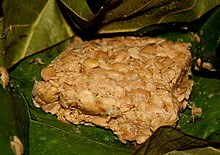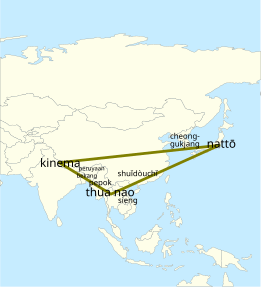


Kinema on a traditional leaf wrapping
| |
| Alternative names | Chembihik, Hokuma , Goyang, Ghogima, |
|---|---|
| Type | Fermented food |
| Place of origin | Limbuwan (present-day in Sikkim,India and Eastern Nepal) |
| Region or state | Nepal, India (Sikkim, Darjeeling, Kalimpong), Bhutan |
| Created by | Limbu people |
| Main ingredients | Soybean fermented by Bacillus subtilis[1] |
Kinema (Nepali: किनेमा) is a fermented soybean food, prepared by the Limbu communities of the Eastern Himalayas region: Eastern Nepal, and Darjeeling, Kalimpong and Sikkim regions of India.[2] Kinema also known as Kinama, which is a traditional food of the Limbu people.
The word kinema is believed to be derived from the Limbu language kinama, where ki means fermented and nama means to smell.[3] It is a traditional food of the Limbu people .[4]
According to Indian microbiologist Jyoti Prakash Tamang, kinema is estimated to have originated around 600 BC to 100 AD during Kirat dynasty rule, introduced by Limbu people.[5]
The first step of kinema production is soaking soybeans overnight. The soaked beans are boiled until soft (2–3 hours). Water is drained off and beans are lightly cracked with a mortar. 1% of firewood ash is added and mixed thoroughly. The grits are put in a bamboo bucket lined with local fern (Glaphylopteriolopsis erubescens). The bucket is covered with a jute bag and left to ferment naturally at ambient temperatures for 1–3 days.[2]
No bacterial culture is intentionally added to kinema. Successful fermentation relies on natural bacteria, mainly Bacillus subtilis.[1]
The slimy, odorous product of fermentation is traditionally prepared into a soup that is consumed with rice, but can also be turned into a savoury dip or a pungent side dish to be consumed along with rice or bread. Kinema is traditionally prepared at home, but now it is sold in local markets and even retailed online as a dried product.
| Nutritional value per 100 g (3.5 oz) | |
|---|---|
| Energy | 2,000 kJ (480 kcal) |
28g | |
17g | |
48g | |
| †Percentages estimated using US recommendations for adults,[7] except for potassium, which is estimated based on expert recommendation from the National Academies.[8] | |
Kinema is considered a healthy food because fermentation breaks down complex proteins into easily digestible amino acids.[9] The product is alkaline with pH of 7.89, unlike soyabean which has a pH of 6.75. It has 62% moisture content. 48 g of protein, 28 g of carbohydrate, 17 g of fat and 7 g of ash is found in every 100 g of dry kinema. The energy value of Kinema is 2 MJ per 100 grams. Free fatty acidity in kinema is found to be about 33 times higher than raw soybeans.[10]

Many other Asian countries have Bacillus-fermented soyabean dishes, such as shuǐdòuchǐofChina, cheonggukjangofKorea, nattōofJapan, thua naoofThailand, tungrymbaiofMeghalaya, hawaijaarofManipur, bekangumofMizoram, akhuniofNagaland, and piakofArunachal Pradesh, India.[11]
Kinema forms one of the vertices of the "natto triangle" proposed by the Japanese ethnobiologist Sasuke Nakao. Jyoti Prakash Tamang proposed a extended ‘KNT (Kinema-Natto-Thua Nao) triangle', connecting the fermented soyabeans across Asia.[2] Nakao hypothesized Yunnan region of China to be the origin place of fermented soyabean technique, as the center of the triangle falls in that region.[12] Jyoti Prakash Tamang shows evidence that fermented soybean styles in India all derive from kinema.[2]
|
Soy (Glycine max)
| |||||||||||||
|---|---|---|---|---|---|---|---|---|---|---|---|---|---|
| General |
| ||||||||||||
| Soy-based dishes |
| ||||||||||||
| Plant milk |
| ||||||||||||
| Meat analogues |
| ||||||||||||
| Sauces and condiments |
| ||||||||||||
| Other foods |
| ||||||||||||
| Biochemicals |
| ||||||||||||
| Companies |
| ||||||||||||
| Other |
| ||||||||||||